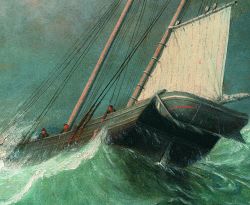loading 
Fitz Henry Lane
HISTORICAL ARCHIVE • CATALOGUE RAISONNÉ • EDUCATIONAL RESOURCE
An online project under the direction of the CAPE ANN MUSEUM
An online project under the direction of the CAPE ANN MUSEUM
Catalog entry
inv. 9
A Smart Blow
Rough Sea, Schooners
c. 1856 Oil on canvas 11 3/4 x 19 in. (29.8 x 48.3 cm) Frame: H. 21 1/4 x 35.6 in. (54 cm) 14 No inscription found
|
Supplementary Images
Provenance (Information known to date; research ongoing.)
the Artist, Gloucester, Mass.
John Trask, Gloucester, Mass., 1856
Caroline W. Trask, Gloucester, Mass.
Cape Ann Museum, Gloucester, Mass., December 21, 1935
Exhibition History
Cape Ann Historical Museum, Gloucester, Massachusetts, The Mysteries of Fitz Henry Lane, July 7–September 16, 2007., no. 24, ill., p. 76.
Traveled to: Spanierman Gallery, New York, N.Y., 4–1, 2007.
Traveled to: Spanierman Gallery, New York, N.Y., 4–1, 2007.
Published References
Wilmerding, John. Fitz Hugh Lane, 1804–1865: American Marine Painter. Salem, MA: The Essex Institute, 1964., fig. 8, p. 40, text, p. 32.
Martha Oaks. "Gloucester At Mid-Century: The World of Fitz Hugh Lane, 1840–1865." Gloucester, Mass.: Cape Ann Historical Society. (exhibition catalogue)., ill., p. 15. ⇒ includes  text
text
Moses, Michael A. "Mary B. Mellen and Fitz Hugh Lane." Antiques Magazine Vol. CXL, No. 5 (November 1991)., p. 831. ⇒ includes  text
text
Craig, James. Fitz H. Lane: An Artist's Voyage through Nineteenth-Century America. Charleston, SC: The History Press, 2006., fig. 43.
Wilmerding, John. "Fitz Henry Lane & Mary Blood Mellen." American Art Review 19, no. 4 (2007)., pp. 170, 175.
Wilmerding, John. Fitz Henry Lane & Mary Blood Mellen: Old Mysteries and New Discoveries. New York: Spanierman Gallery, 2007., no. 24, p. 76. ⇒ includes  text
text
Wilmderding, John. "The Identities of Mr. Nathaniel Rogers." Maine Boats, Homes & Harbors 97, no. 20 (Winter 2008). Includes excerpts from Fitz Henry Lane and Mary Blood Mellen: Old Mysteries and New Discoveries, by John Wilmerding. New York: Spanierman Gallery, 2007., p. 54. ⇒ includes  text
text

Commentary
This modest-sized painting, only 11 x 19 inches, is notable in that it is one of the rare paintings by Lane showing men fishing at sea as opposed to inshore. In this case, the men are hand-lining for cod or halibut off the side of the vessel. A scene such as this would have been common out on Georges Bank, an elevated area of the sea floor only sixty miles east of Gloucester.
Georges Bank was an abundant fishery that supported the Gloucester fleet for hundreds of years. As the inshore cod stocks were depleted near Cape Ann in the early 1800s, larger boats were built that could fish Georges Bank and return within several days. There was a growing demand for fresh fish in Boston, and the coming of the railroad to Gloucester in 1848 made it possible for the catch to get to the Boston market only a few hours after reaching the dock.
The Gloucester fishing fleet prospered and grew in numbers and vessel size, venturing ever farther afield in search of fish. However, fishing in the 1850s was still a crude and inefficient business. The men shown here are simply hand-lining off the rail and will pull in one or two fish at a time until the hold is full or until they need to run back to port. The great days of the Gloucester schooner fleet, when men in dories spooled out mile-long lines of hooks that could catch hundreds of fish at a time, were still twenty or so years in the future.
Both vessels in A Smart Blow carry a schooner rig, reefed down to handle the stiff breeze that is a near constant in the North Atlantic. Note the yawl boat hanging off the stern of the foreground vessel. For all the somewhat flat, two-dimensional quality of this painting, the yawl boat is beautifully volumetric, with an integrity of shape and a living, porpoise-like roundness that sets it off from the rest of the painting. This foreground schooner cresting the wave was later copied by Captain Addison Carter and used in his 1872 design of the Gloucester City seal (see below).
The other unusual element of this painting is the loose and energetic brushwork, particularly in the sky and wave-tops. Lane has laid on the paint more freely and with less blending than was his usual meticulous style. Seen up close, the oranges and pinks in the clouds and deep blues and blacks of the sky become a beautiful abstraction in themselves. Lane has painted the faces of the fishermen bright red, a wonderfully expressionist touch that belies his ultra-realist reputation.
The composition of A Smart Blow has a primitive charm to it. The angles of the heeling vessels' masts are perfectly matched, and the vessels sail in exactly opposite directions. The dark wave-shadow and spray in the lower right starts the eye on a counterclockwise motion to the far vessel, then moves left to the light in the sky, and back down to the larger vessel. The eye can just as easily travel in a clockwise motion. This opposing, circular symmetry adds to the primitive quality of the painting. It reminds us that Lane’s earliest exposure to paintings would have been to the work of early-American limners whose bold, patterned work (now called folk or naïve art) is seen as so distinctly American.
This is one of many paintings by Lane of which a copy exists by his pupil, Mary Mellen. The painting may be the one mentioned in the newspaper article below; if so, it would indicate that it was well-known.
– Sam Holdsworth